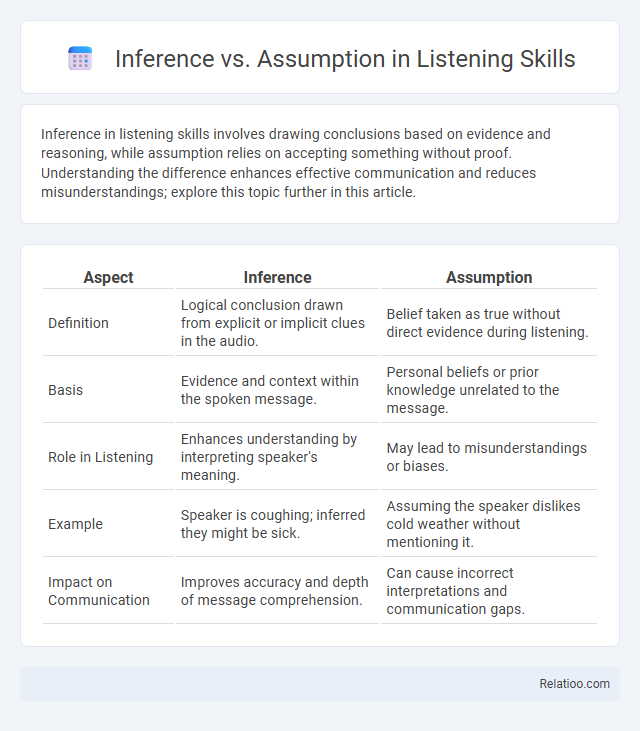Inference in listening skills involves drawing conclusions based on evidence and reasoning, while assumption relies on accepting something without proof. Understanding the difference enhances effective communication and reduces misunderstandings; explore this topic further in this article.
Table of Comparison
| Aspect | Inference | Assumption |
|---|---|---|
| Definition | Logical conclusion drawn from explicit or implicit clues in the audio. | Belief taken as true without direct evidence during listening. |
| Basis | Evidence and context within the spoken message. | Personal beliefs or prior knowledge unrelated to the message. |
| Role in Listening | Enhances understanding by interpreting speaker's meaning. | May lead to misunderstandings or biases. |
| Example | Speaker is coughing; inferred they might be sick. | Assuming the speaker dislikes cold weather without mentioning it. |
| Impact on Communication | Improves accuracy and depth of message comprehension. | Can cause incorrect interpretations and communication gaps. |
Understanding Inference in Listening
Understanding inference in listening involves grasping implied meanings beyond the spoken words by analyzing tone, context, and nonverbal cues. Your ability to infer helps decode the speaker's intent, emotions, and unstated information, enhancing overall comprehension. This skill differs from assumption, which often lacks evidence and can lead to misunderstandings.
Defining Assumption in Communication
An assumption in communication refers to accepting something as true without concrete evidence, often leading to misunderstandings. In contrast, inference involves drawing logical conclusions based on evidence and context during listening. Enhancing your listening skills requires distinguishing between assumptions that may distort meaning and inferences that clarify speaker intent.
Key Differences Between Inference and Assumption
Inference involves drawing logical conclusions based on available evidence and context, whereas assumption is accepting something as true without sufficient proof. In listening skills, inference requires critical thinking to interpret meaning beyond explicit statements, while assumption often leads to misunderstandings due to lack of verification. Understanding this distinction enhances effective communication by promoting clarity and reducing errors in message interpretation.
The Role of Inference in Effective Listening
Inference in effective listening involves actively interpreting and connecting explicit information with prior knowledge to derive meaning beyond what is directly stated. This cognitive process enables listeners to understand context, intentions, and emotions, improving comprehension and communication accuracy. Unlike assumptions, which are often baseless guesses, inferences are logically grounded conclusions drawn from available auditory cues and context.
How Assumptions Affect Listening Comprehension
Assumptions can distort your listening comprehension by causing you to interpret information based on preconceived notions rather than the speaker's actual message. This often leads to misunderstandings and missed nuances, as assumptions fill gaps with inaccurate content. Developing strong inference skills helps you interpret meanings directly from context, improving clarity and response accuracy in communication.
Avoiding Misunderstandings: Inference vs Assumption
Inference involves drawing conclusions based on evidence and logical reasoning, while assumption relies on preconceived notions without sufficient proof. In listening skills, making accurate inferences helps you avoid misunderstandings by interpreting messages carefully and contextually. Relying on assumptions, however, increases the risk of miscommunication and inaccurate judgments during conversations.
Developing Critical Listening Skills
Inference in listening involves drawing logical conclusions from the information provided, while assumption relies on preconceived notions without concrete evidence. Developing critical listening skills requires distinguishing between what is explicitly stated and what is inferred, enabling You to evaluate the speaker's message accurately. Strengthening this ability enhances comprehension and prevents misinterpretation in complex communication situations.
Common Examples of Inference and Assumption
Inference in listening skills involves drawing logical conclusions from spoken information, such as understanding a speaker's mood from tone or interpreting implied meanings beyond explicit words. Assumption occurs when a listener accepts information as true without evidence, like believing a statement is factual simply due to the speaker's confidence. Common examples of inference include deducing a speaker's feelings from context clues, while assumptions often involve jumping to conclusions about a speaker's intentions without clarification.
Strategies to Minimize Assumptions While Listening
Effective listening requires distinguishing between inference and assumption by relying on context clues and verifying information through active engagement. Strategies to minimize assumptions involve asking clarifying questions, paraphrasing the speaker's message, and maintaining an open mindset to avoid filling gaps with unsupported beliefs. Practicing these techniques enhances comprehension and reduces misunderstandings in communication.
Enhancing Communication through Accurate Inference
Enhancing communication through accurate inference involves carefully interpreting spoken information beyond mere assumptions, which often rely on incomplete or biased understanding. Your ability to distinguish between inference, which is based on logical reasoning and contextual clues, and assumption, which may lack evidence, improves comprehension and response accuracy in listening skills. Developing this skill reduces misunderstandings and fosters more effective, meaningful conversations.

Infographic: Inference vs Assumption in Listening Skills
 relatioo.com
relatioo.com